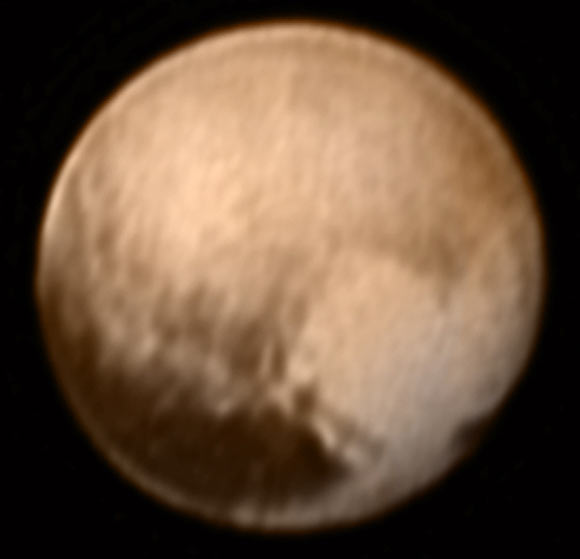NASA’s New Horizons will complete a close flyby of Pluto today at 7:49 a.m. EST (4:49 a.m. PST, 11:49 a.m. GMT, 1:49 p.m. CET, 5:19 p.m. IST, 9:49 p.m. AEST).
New Horizons won’t be making observations alone. NASA’s space fleet will be busy gathering data before and after to help piece together what we know about the dwarf planet, and what features New Horizons data might help explain.
“NASA is aiming some of our most powerful space observatories at Pluto. With their unique capabilities combined, we will have a multi-faceted view of the Pluto system complementary to New Horizons data,” said Dr Paul Hertz of NASA Headquarters, Washington.
Right around New Horizons’ closest approach to the Pluto system, NASA’s Cassini spacecraft will take an image of the dwarf planet from its station in orbit around Saturn.
Although Cassini is the closest spacecraft to New Horizons’ distant location, the image of Pluto will be but a faint dot on a field of stars.
Even so, the image will provide a scientific measurement of Pluto from a different vantage point that will complement data collected by New Horizons.
“The Cassini team has been pleased to provide occasional imaging support for New Horizons for several years to aid with the Pluto-bound spacecraft’s navigation. It’s great to provide one last look at it soars through the Pluto system,” said Dr Earl Maize of NASA’s Jet Propulsion Laboratory in Pasadena, a manager for the Cassini mission.
Even after New Horizons flies past Pluto, the observations don’t end there.
On 23 July 2015, NASA’s Spitzer Space Telescope will begin a seven-day series of observations. The data will reveal possible changes in ice on Pluto’s surface.
“Spitzer is around 3 billion miles (4.87 billion km) from Pluto. The spacecraft provides an effective tool to study the ice on the surface and search for other materials that have not yet been identified,” said Dr Noemi Pinella-Alonso from the University of Tennessee in Knoxville, lead investigator of the Spitzer observations.

This image of Pluto from New Horizons was received on July 8, 2015, and has been combined with color information from the spacecraft’s Ralph instrument. The image was taken on July 7, when New Horizons was 5 million miles (8 million km) from the dwarf planet. Image credit: NASA / Johns Hopkins University Applied Physics Laboratory / Southwest Research Institute.
Beginning in October 2015 NASA’s Kepler Space Telescope will observe Pluto for nearly three months. Similar to how Kepler detected exoplanets by measuring the change in brightness from their host star, Kepler will record the change in the reflected light off Pluto and its largest moon, Charon.
NASA researchers will learn more about the effects on the atmosphere and surface of Pluto imparted by the dwarf planet’s eccentric and expanding orbit about the Sun.
“Kepler observations will expand the time coverage of the speedy New Horizons’ flyby of Pluto, making observations of the dwarf planet-moon system every 30-min,” said Dr Steve Howell of NASA’s Ames Research Center, a project scientist for Kepler/K2.
“We are excited to turn the planet-hunting Kepler spacecraft’s attention to this distant solar system object to provide additional scientific insight into this far off, mysterious world, itself a miniature solar system of five moons in orbit about Pluto.”







